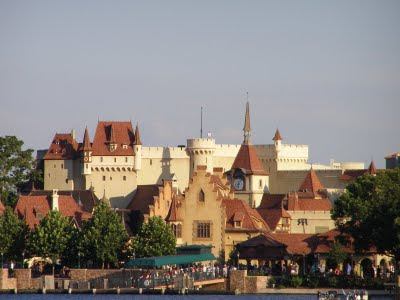
Except, that is, when it doesn't.
So, from time to time, EPCOT Central will explore aspects of EPCOT that fulfill the vision of this grandest of all theme parks ... as well as those that, well, don't.
And why not start with some controversy?
Many readers abhor the revised descent/ending to Spaceship Earth, but EPCOT Central thinks it works. Here's why:
From its very start, EPCOT Center was focused on how you, the guest, would live and interact with your future world. In EPCOT's earliest incarnation, much of that exploration was done with gravity and seriousness -- a little too much. Indeed, World of Motion is fondly recalled not so much because it was actually good (it wasn't, really; though it was at least an elaborate example of the kind of Animatronic-filled ride-through that no one but Disney could do then ... or has ever been able to do). Rather, World of Motion was singled out because it at least attempted to be humorous.
There weren't many examples of that in EPCOT Center. Cute little Figment over in Journey Into Imagination was certainly fun. World of Motion was played (mostly) for laughs. And Cranium Command -- well, it was in a class by itself. But humor, for the most part, was overshadowed by education.
At the same time, Spaceship Earth, quite (OK, almost) literally the centerpiece attraction in EPCOT, was a terrific experience all the way to the top ... and then a drag on the way down. From the get-go, Imagineers sent a not-so-subtle message to riders of those backwards-swiveling "time machines": The show's over, nothing left to see.
In the mid-1990s, an attempt was made to make the descent more interesting. One idea, if it had actually played out (something that would be easy to do today but wasn't too easy in 1994), was to show today's world news from around the world. That was, at least, the idea behind the scenes of newscasters projected on a screen at the beginning of the descent. But it wasn't possible, in the pre-Internet, narrow-band days, to actually stream live news, so the concept was never realized.
Static figurines of kids and adults in an "interconnected" world never sparked the imagination, and were, frankly, boring. A lovely cityscape was built with a terrific fiber-optics depiction of "flowing information," but more often than not, it was dark and dull.
The descent never worked, was never engaging.
Now, it's a fun combination of technology and interactivity. It's understandable if your heart sinks a bit the first time you see a monitor in a Spaceship Earth time machine -- is this going to be another example of on-screen distraction that tries to hide the flaws of the ride itself? But after asking a few questions, the screen goes dark and doesn't bother riders until the descent begins.
At that point, the ride becomes a highly individualized, clever and cute diversion. Mashing your face together with a retro cartoon vision of the future, Spaceship Earth now follows its information-rich, education-focused "main show" with some fun, relaxing smiles. I've yet to encounter anyone -- even if they objected to the comedic tone -- who didn't crack a grin. And that's saying something.
It's particularly noteworthy in today's "Disney Parks" environment, because the grin comes without a single Disney character. It's the Disney touch that makes this work. It's a fine bit of Disney nonsense, in keeping with the manic tradition of later Donald Duck cartoons, Alice In Wonderland and Disney's stylized 1950s Cinemascope efforts.
The downside is a lost opportunity -- these peeks at the "future" could have been based on real science, rather than a goofy, retro vision of bubble-shaped saucer cars and robotic homes. That future is likely never to be a reality, and while it's cute to see this kitschy '50s notion of "The Future." There's no science here, only silliness. That's indeed too bad.
But it would be worse, really, to stare at dusty old statues prophesying a future in which we all connect by -- wow! -- live videoconferencing. That concept of "the future of communications" pre-dated Facebook and MySpace and YouTube, which have changed the lives of everyone on the planet, even people who don't use them.
Besides, this version (at least theoretically) is easily changeable, and it's undeniable fun to spend a few moments in the dark answering the on-screen questions about taste and preference. There's music, there's dramatic lighting, and there's a magician's flair for distraction -- you don't notice, and you don't care, that nothing is happening around you. Watching the resulting cartoon with your face is great fun. And, what's this? For once, Disney doesn't try to sell you a picture of yourself!
Spaceship Earth as a whole works wonderfully now, a lovely balance of seriousness and humor, of education and mirth. The theme is still problematic -- it's no longer technically about communication, and despite its claims it isn't really about innovation. Actually, it is about human communication and all it has meant to our planet, but since the final cartoon doesn't uphold that theme, Disney opted instead for a confusion thematic claim countered by a different thematic execution.
Nonetheless, the new Spaceship Earth descent works, and sets the tone wonderfully for EPCOT as a whole. It's about you and your role in shaping the future. It's a blend of fun and fact. It's a modern spin on a timeless tale of human endeavor.
Now, if the rest of Future World would just get with the program ...




























